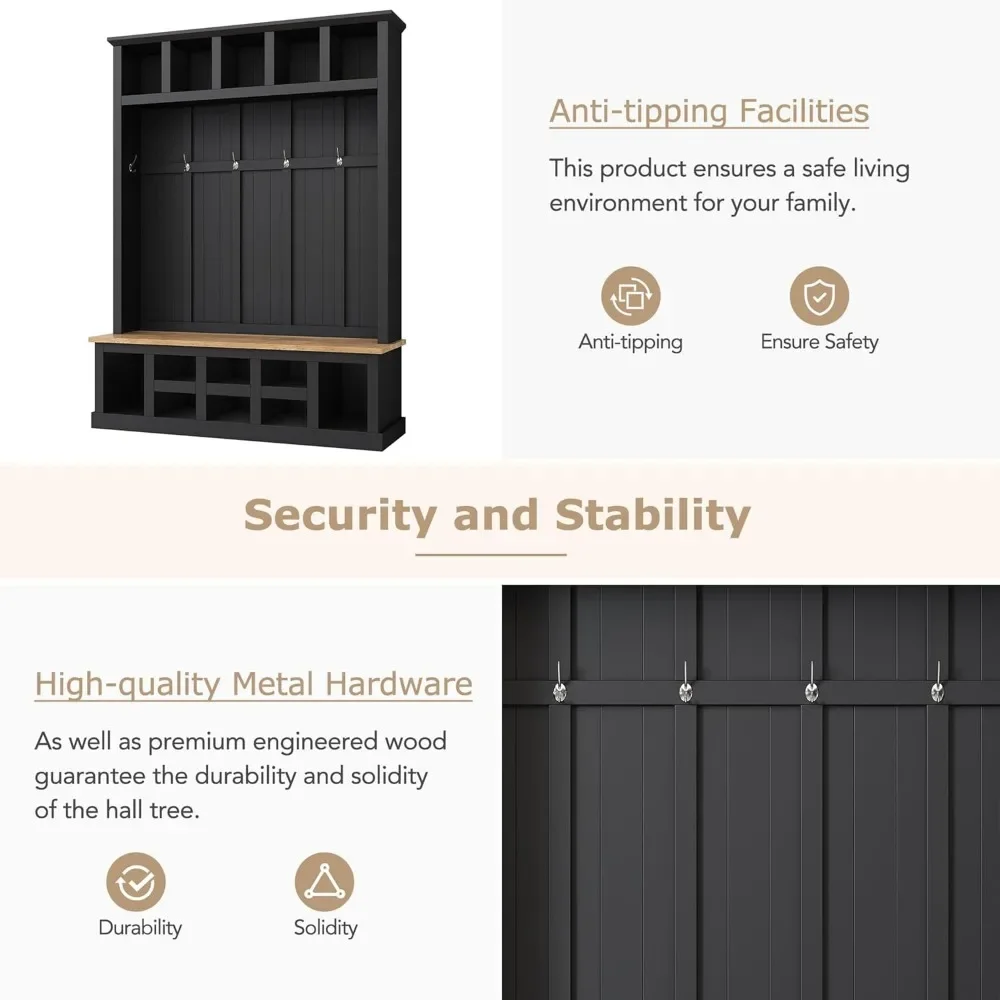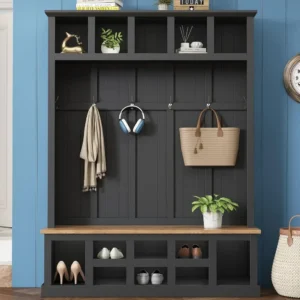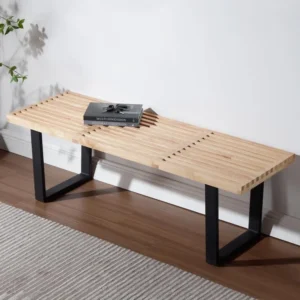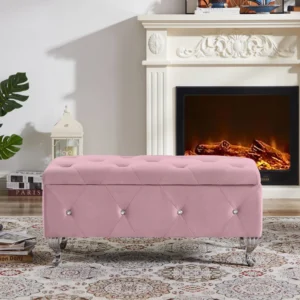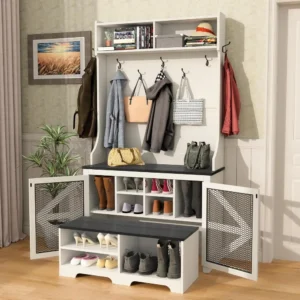Introduction: Maximizing Function in Limited Entryway Space
Creating an organized entryway in a compact home presents unique challenges. When space comes at a premium, every inch matters, especially in high-traffic areas like mudrooms. Limited square footage doesn’t have to mean limited functionality, though. The right mudroom bench can transform even the smallest entryway into an efficient, organized space that welcomes you home.
Today’s urban apartments and modern homes often feature entryways averaging just 25-35 square feet, making smart organization essential. Many homeowners struggle with daily entryway clutter – scattered shoes, nowhere to sit when removing boots, and coats that end up draped over furniture instead of properly hung up.
Finding a bench with the right features for your specific space constraints can dramatically improve your daily routine. In this guide, we’ll explore the essential elements to look for when selecting a mudroom bench for small spaces, helping you maximize both function and style. The principles of space-saving benches apply whether you’re working with a dedicated mudroom or simply creating a functional entry zone.
Understanding Your Space Constraints Before Shopping
Before selecting a mudroom bench, thoroughly assess your available space to ensure the perfect fit. Taking accurate measurements prevents purchasing a bench that overwhelms your entryway or fails to meet your organizational needs.
When measuring your space:
– Measure width (wall to wall) where the bench will be placed
– Determine maximum acceptable depth (how far the bench can extend into the space)
– Consider height limitations, especially if placing under existing hooks or shelves
– Allow at least 24 inches (61 cm) of clearance in front of the bench for comfortable access
– Account for door swing radius to prevent blocking entry/exit paths
Different small-space configurations require different bench solutions. Narrow hallways benefit from slim-profile designs, while apartment entryways might need corner units to maximize available space. Some homes have shared mudroom-laundry areas requiring extra-compact solutions.
Setting realistic expectations about what can fit in your space helps narrow your search to truly compatible options. Consider how the organization of your small entryway impacts daily use – a bench that’s perfect on paper but blocks natural movement through your space will quickly become frustrating.
Essential Space-Saving Design Features
Compact Footprint Dimensions
When space is limited, every inch counts. Look for benches with slim profiles that don’t sacrifice functionality. Optimal dimensions for small spaces include:
- Depth: 12-17 inches (30-43 cm) provides sufficient seating without protruding too far
- Height: 17-19 inches (43-48 cm) offers comfortable seating while maintaining proper posture
- Width: For single-person seating, 24-30 inches (61-76 cm) works well in tight spaces
Space-Efficient Design Elements
Clean lines and minimal ornamentation do more than just look modern – they physically take up less space. Benches with visual “lightness” created through open frames or elevated legs can make your entryway appear more spacious than bulky, solid alternatives.
Wall-mounted or floating bench designs eliminate the need for legs entirely, creating usable floor space underneath for shoes or small storage bins. This approach works particularly well in extremely narrow entryways where floor space is at a premium.
Corner bench configurations transform often-wasted corner spaces into functional seating and storage areas. These L-shaped designs can fit snugly into corners while providing two sides of usable bench space, effectively doubling functionality without increasing the footprint.
The best entry benches for small homes balance minimal dimensions with maximal functionality through clever design. Many homeowners find that narrow entryway benches with widths under 36 inches provide the perfect solution for tight spaces without sacrificing essential features.
Multi-Functional Storage Solutions
Under-Bench Storage Options
The space beneath your bench represents valuable storage real estate in a small mudroom. Different under-bench configurations offer various advantages:
- Open cubbies and shelving: Provide quick access and visibility of items, perfect for shoes that need air circulation. No doors means less space required for operation.
- Drawers and cabinets: Conceal clutter and protect items from dust. Ideal for storing seasonal accessories or items you don’t need daily access to.
- Lift-top storage compartments: Maximize the entire bench footprint for storage without requiring additional clearance for doors or drawers to open outward.
- Pull-out baskets and bins: Combine the accessibility of open storage with the organization of contained storage. Removable bins make cleaning underneath simple.
Vertical Storage Integration
Small spaces benefit tremendously from vertical thinking. Many compact mudroom benches integrate upward storage elements:
- Coat hooks and hanging systems: Transform wall space above and behind the bench into functional storage for jackets, bags, and accessories.
- Upper shelving and cabinets: Provide enclosed storage for seasonal items or less frequently used gear.
- Integrated mirror options: Serve dual functions of visual space expansion and practical use for last-minute appearance checks.
Specialized Shoe Storage Solutions
Footwear often creates the most entryway clutter. Look for benches with:
- Slat shelves: Allow air circulation to dry damp shoes and prevent odors.
- Tilted shoe compartments: Display shoes for easy selection while maximizing vertical storage efficiency.
- Hidden shoe drawers: Keep footwear accessible but concealed for a cleaner appearance.
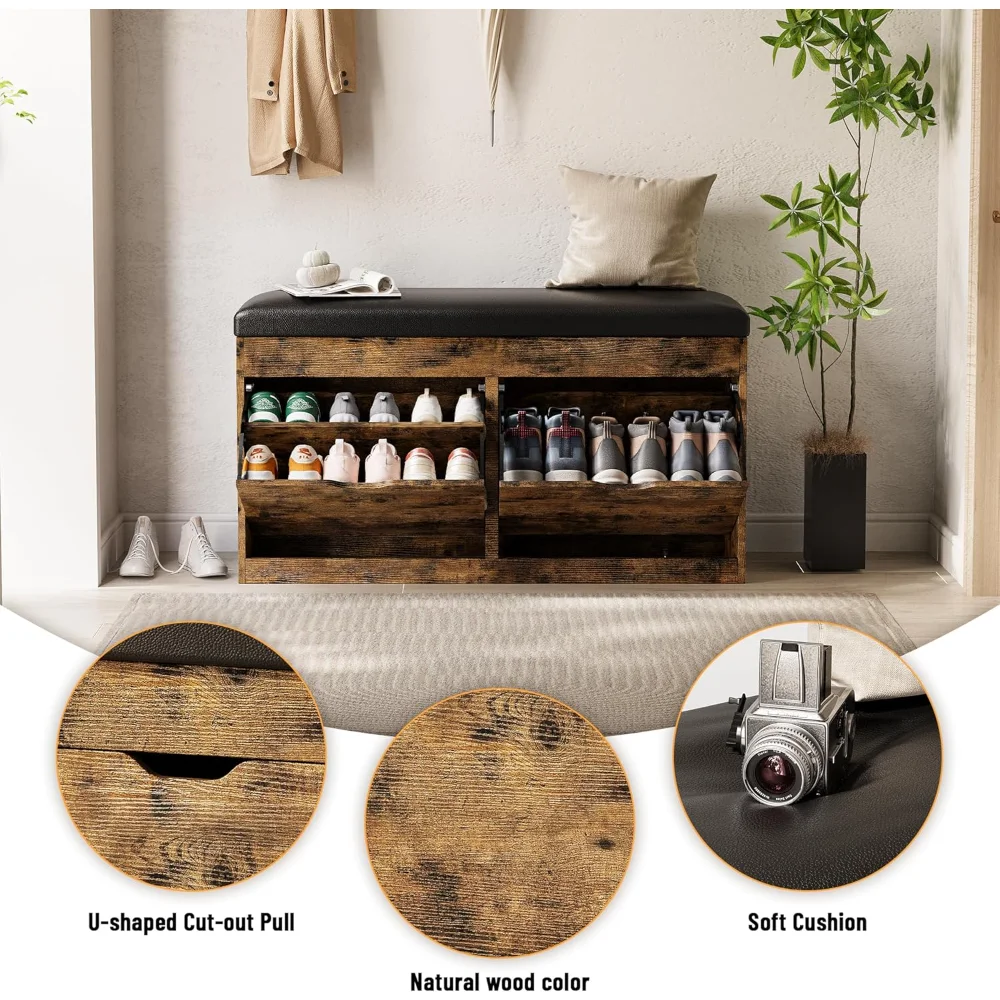
The most effective space-saving entryway ideas incorporate multiple storage types within a single piece. For many households, dedicated mudroom benches with shoe storage solve two critical organizational challenges simultaneously without requiring additional furniture pieces.
Smart Materials and Construction for Durability
Material Options for High-Traffic Areas
The materials you choose significantly impact both the durability and space perception of your mudroom bench:
- Solid woods like oak, maple, and walnut offer exceptional durability and timeless appeal. In small spaces, lighter-colored woods like maple can help the area feel more open and less confined.
- Engineered woods and composites provide cost-effective alternatives with good moisture resistance – particularly important in mudroom environments where wet items are common.
- Metal and mixed-material designs often feature slimmer profiles and open frameworks that create a sense of lightness, making them excellent choices for visually expanding tight spaces.
Finish Considerations
Mudrooms endure tough conditions, from wet boots to sandy backpacks. Optimal finishes include:
- Water-resistant sealants that prevent moisture absorption and warping
- Easy-clean surfaces that withstand regular wiping and disinfecting
- Scuff-resistant coatings that maintain appearance despite constant contact with shoes and boots
Construction Quality Indicators
In small spaces, stability is paramount as the bench will likely be positioned against walls or in corners. Look for:
- Solid joinery methods like dovetails or mortise-and-tenon connections rather than just glue and staples
- Weight capacity ratings appropriate for your household needs (typically 250-400 pounds)
- Pre-assembled sections that minimize the complexity of setup in tight spaces
Wood mudroom benches offer exceptional durability when properly sealed and maintained. The natural warmth of wood creates an inviting atmosphere even in the smallest entryway, while providing the strength needed for daily use.
Space-Enhancing Visual Design Elements
Light-Enhancing Design Features
The visual perception of space can be dramatically influenced by your bench’s design:
- Light-colored finishes in white, cream, or light gray reflect more light and make spaces feel larger
- Reflective or glossy surfaces bounce light throughout the space, enhancing brightness
- Open elements like slatted shelving or benches with negative space reduce visual weight
Visual Proportions for Small Spaces
Not all bench designs are created equal when it comes to small spaces:
- Vertical emphasis draws the eye upward, creating a perception of height and spaciousness
- Slim legs or wall-mounting creates visual breathing room beneath the bench
- Appropriately scaled details (smaller hardware, thinner arms) maintain proportional harmony
Design Styles for Compact Areas
Certain design approaches naturally complement small spaces:
- Minimalist and Scandinavian influences emphasize clean lines and functional simplicity
- Space-efficient modern designs integrate multiple functions without visual clutter
- Compact interpretations of traditional styles offer familiarity without overwhelming bulk
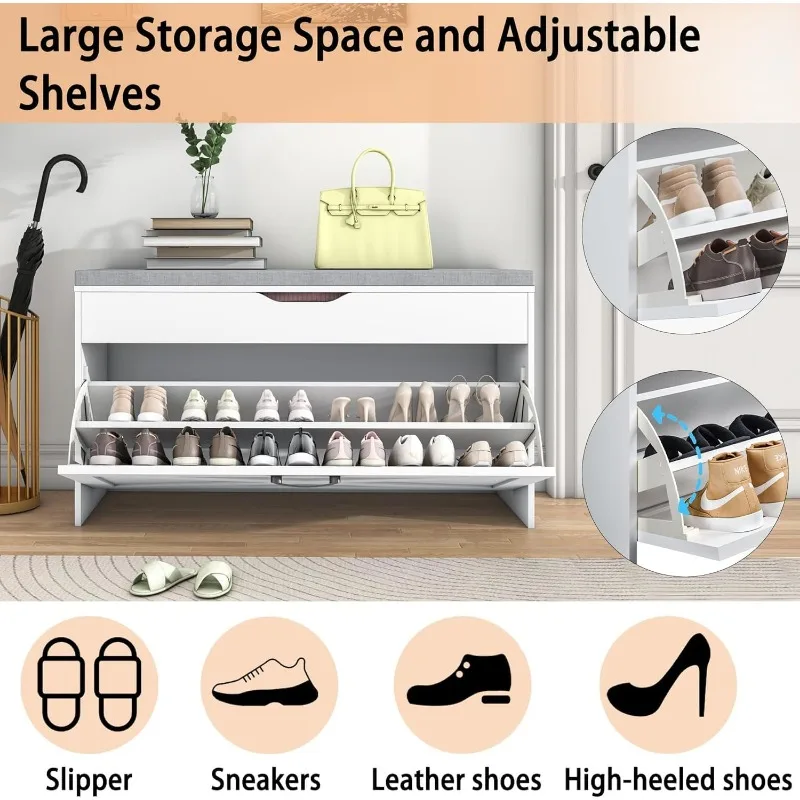
When planning the perfect tiny mudroom, remember that visual simplicity often creates the most functional and spacious-feeling result. A bench with too many decorative elements can make a small space feel cluttered before you’ve even added your personal items.
Clever Dual-Purpose Features for Maximum Utility
All-in-One Units
The most space-efficient solutions combine multiple functions into cohesive units:
- Hall tree configurations integrate seating, hanging storage, and shelving in a single footprint
- Bench-cabinet hybrids provide enclosed storage while offering comfortable seating
- Entry table conversions allow a surface to transform from display to seating as needed
Smart Functional Additions
Small details can significantly enhance functionality:
- Built-in boot trays and drip mats collect moisture and debris, protecting your floors
- Integrated charging stations keep devices powered while creating a dedicated spot for phones and keys
- Concealed message centers or key storage keeps essential items organized but out of sight
Adaptable Features
Flexibility is particularly valuable in small spaces:
- Expandable elements adjust to different needs or seasonal changes
- Modular components allow customization within tight constraints
- Nesting or folding capabilities permit temporary expansion when needed
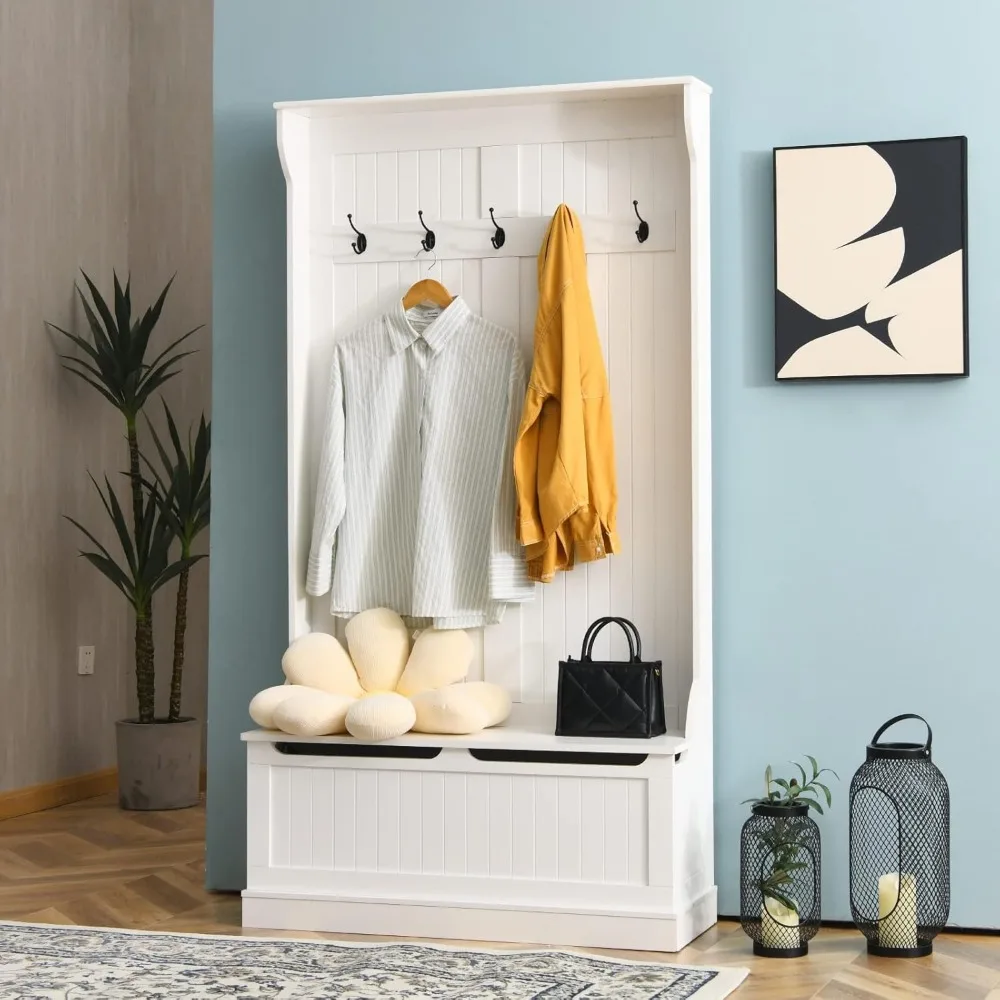
Coat Rack Shoe Bench, Corner Entryway Bench, Corner Hall Tree, Shoe Bench for Entryway
$313.58 Select options This product has multiple variants. The options may be chosen on the product pageBench with Hooks and Storage, Entryway Hall Tree, Mudroom Bench with Cubbies, Mudroom Bench with Shoe Storage
$818.38 Select options This product has multiple variants. The options may be chosen on the product pageModern Entryway Bench, Wood Entryway Bench, Wood Mudroom Bench
$497.69 Select options This product has multiple variants. The options may be chosen on the product pageEntryway Coat Rack Bench, Entryway Hall Tree, Farmhouse Mudroom Bench, Mudroom Bench with Shoe Storage
$805.09 Select options This product has multiple variants. The options may be chosen on the product pageEntryway Bench with Cushion, Small Entryway Bench
$466.79 Select options This product has multiple variants. The options may be chosen on the product pageBench with Hooks and Storage, Entryway Coat Rack Bench, Entryway Hall Tree, Mudroom Bench with Shoe Storage, Mudroom Coat Rack Bench
$793.73 Select options This product has multiple variants. The options may be chosen on the product page
Investing in entryway hall trees combines multiple furniture pieces into one efficient unit, saving up to 40% of floor space compared to separate bench, coat rack, and storage cabinet arrangements. Similarly, benches with integrated hooks and storage maximize functionality without requiring additional wall-mounted fixtures.
Strategic Placement and Installation Tips
Optimal Positioning
How and where you place your bench significantly impacts both functionality and perceived spaciousness:
- Against walls: Traditional placement maximizes floor space; consider wall protection behind the bench
- In corners: Utilizes often-overlooked space; look for specially designed corner units
- Creating mini-mudrooms: Clever placement can define an entryway zone in open floor plans
- Utilizing awkward areas: Spaces under stairs or in recessed areas can become functional with the right bench dimensions
Installation Considerations
Proper installation ensures safety and maximizes space efficiency:
- Secure mounting to wall studs prevents tipping, especially important for bench-shelf combinations
- Adjustable feet compensate for uneven floors, ensuring stability without rocking
- Pre-assembly of major components before placing in tight spaces simplifies installation
Complementary Elements
Enhance your bench’s functionality with thoughtful additions:
- Strategic lighting improves visibility and makes the space feel larger
- Durable wall treatments behind benches prevent damage from shoes and bags
- Floor protection like washable rugs or mats catches debris and simplifies cleaning
Corner hall trees offer specialized solutions for maximizing awkward corner spaces that might otherwise go unused. When measuring for corner units, remember to account for baseboard clearance and ensure doors can open fully without obstruction.
Customizing Your Small-Space Mudroom Bench
Space-Efficient Personalization
Add personality without sacrificing precious space:
- Cushions and fabric selections add comfort and color while remaining removable for cleaning
- Hardware upgrades provide visual interest without dimensional changes
- Color and finish choices can coordinate with your existing decor while maintaining a cohesive look
DIY Modifications
Adapt existing pieces to better suit your specific needs:
- Add hooks at various heights to accommodate different family members
- Install dividers in open cubbies to organize smaller items
- Create custom cushions that precisely fit your bench dimensions
Seasonal Adaptation
Flexible organization helps manage changing needs throughout the year:
- Winter configurations might prioritize boot storage and coat hooks
- Summer setups can accommodate beach bags and gardening supplies
- Holiday adjustments make space for guest coats or special seasonal decor
These smart entryway bench solutions allow your space to evolve with your needs throughout the year without requiring complete reorganization.
Buyer’s Guide: Selecting the Perfect Small-Space Mudroom Bench
Essential Measurements
Before making a final selection, verify these critical specifications:
- Complete external dimensions (height, width, depth)
- Interior storage dimensions for items you plan to store
- Clearance requirements for doors, drawers, and lids
- Weight capacity appropriate for intended use
- Assembly space needed during installation
Feature Prioritization
Not all features hold equal importance for every household:
- Family size and composition: More household members typically require more hooks and storage
- Primary vs. secondary entrance: Main entrances need higher durability and capacity
- Seasonal considerations: Winter gear requires more robust storage than summer items
Budget Considerations
Quality investments in small-space solutions often pay dividends in functionality:
- Entry-level options ($100-200) typically offer basic seating with minimal storage
- Mid-range benches ($200-400) incorporate multiple storage types with better materials
- Premium solutions ($400+) feature superior construction, materials, and specialized space-saving designs
The small entryway bench category offers numerous options specifically designed for compact spaces, with features optimized for maximum efficiency in minimal footprints.
Conclusion: Transforming Your Small Entryway with the Right Bench
Even the smallest entryway can become a highly functional, organized space with the right mudroom bench. By prioritizing compact dimensions, multi-functional storage, and durable materials, you can create an entryway that efficiently handles daily traffic while maintaining an inviting appearance.
Remember that in small spaces, every feature should serve a purpose. Focus on the elements most important to your household’s specific needs rather than trying to incorporate every possible option. The perfect bench balances your storage requirements, available space, and aesthetic preferences to create a harmonious entryway solution.
With thoughtful selection, your small-space mudroom bench can become the organizational hub that transforms your daily coming and going from chaotic to calm, proving that limited square footage doesn’t have to mean limited functionality.

